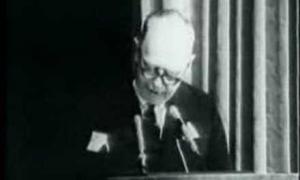The Speechwriter’s Life: Former gubernatorial speechwriter Jim Bray
June 21, 2015
Transitioning from journalism to speechwriting, he had to learn that "unlike a newspaper story, a speech only has to give one side of the story, and make just one argument,”
You’re a just-appointed CEO, or a newly-elected government official. Among the perks you now enjoy is money in the budget to hire a speechwriter. If you’re unsure about what to do next, then former Illinois gubernatorial speechwriter Jim Bray has some advice for you: “First, remember that a speechwriter is a different kind of hire than you make with many on your staff. You’re selecting someone you must trust to put words in your mouth.”
“Your term in a top job is too short for you to settle for mediocre. Keep the hiring process going until you find the person who is the best fit for you. And you shouldn’t expect to hire a speechwriter, sit that person two floors away from you, and then receive perfectly polished copy for your next speaking appearance. The speechwriter needs access to you, to learn about your style, your approach to speeches and your messages – and to gather your feedback. So invite the speechwriter to some (not all, of course) of your meetings, and provide that individual with opportunities to learn what you’re thinking about,” Bray added.
Bray entered speechwriting in 1985, when he joined the office of Governor Jim Thompson, Illinois’ longest-serving governor (1977-1991). Bray had covered state politics as a newspaper reporter for 10 years,” so it was easier for me to write speeches for Governor Thompson [than someone who started cold], because I knew the issues and the recent history and his speaking style,” Bray said.
“Sometimes, at the start, I wasn’t sure if what I had written was strong enough – there was a learning curve, but not that steep. Unlike a newspaper story, a speech only has to give one side of the story, and make just one argument,” he observed.
“Governor Thompson was (and is) a gifted speaker. His day-to-day speeches, to business groups or labor groups or teachers and so on, were written as talking points, along with some additional information about the audience, and he would take it from there. There were two or three major speeches a year that required a full-blown text – the Budget, the State of the State and usually one additional speech highlighting a particular initiative to a large audience. In the weeks following major speeches, the Governor would deliver versions of those major speeches to various audiences, based on the main themes he had to hit, again using talking points. When drafting those talking points, my goal would be to come up with something new to start out his remarks, to change things up – perhaps a hook to the local audience, or that day in history, or what he did before that audience last year, or the last time he was in that part of the state,” Bray said.
“There were times in my tenure and the tenure of other speechwriters when, the night before an important speech, Thompson took a legal pad and rewrote much of the prepared speech, and then presented his scribbled notes the next day to be fed into a Teleprompter with little time to spare. The good days were when someone on staff came to me and said, ‘the Governor delivered your speech today – you must be doing a good job.’ I had the good fortune to write for someone who was both a great speechwriter and speech giver, and it often was a surprise when he stuck to a draft. At times, when I was drafting, I had an audience of one. Fortunately, he did not expect to pick up a speech and use every word – the draft would help him get started, and he would finish it,” Bray added.
***
When asked about what he considered the most memorable speech of his years writing for Governor Thompson, Bray mentioned Thompson’s January 10, 1990 State of the State speech, a combination farewell address and summary of his political career, as he was not seeking re-election. “The speech was an opportunity for the Governor to look back on the last 13 years, where the state had come from, and to defend his record against people who wanted to complain about it, as happens in every election campaign,” Bray recalled.
The speech included the following reflections:
In 1977, I stood at this same podium and declared [that] the war between the General Assembly and the Governor’s Office [was] over. We have kept that peace, and the citizens of Illinois have received the peace dividends. Now granted, we’ve had our skirmishes. Battles go with the territory when people’s lives and homes and jobs are at stake. And especially in Illinois, where we take our politics very, very seriously. But those battles, our battles, have been ones of philosophy and political will. The former contests were mean spirited, personality driven arguments, detrimental to the entire state, and only a cease fire would have allowed us to succeed.
As our relationships became more civil, so, too, did the relationship between business and labor. Each still squares off on issues involving ideology, but now they talk to each other and, more importantly, they listen to each other—and more importantly [sic], they act together…And together business, labor and I have convinced the world that Illinois is a good place to do business.
That may sound like ancient history to many of you…only 58 members of the General Assembly were here in 1977. It may seem like some of us never go away. And it may seem like some problems never go away. And no, the two are not related…
In the last 13 years, state government has delivered efficiently more services in more areas to more people than at any time in our history. Whole programs that didn't even exist in 1977, thrive now. And yet, the share of the dollars that we take from our people's income in Illinois to do all that is lower — not higher — lower than it was in 1977. Imagine that. More government, better government costing you less in 1990 than it cost you in 1977.
***
Bray concluded his discussion with Vital Speeches by sharing some insights into the behind-the-scenes work that goes into a major gubernatorial speech such as a budget speech or State of the State. “With any major speech, people on the Governor’s staff will want particular projects that they support to be mentioned in the text. This isn’t just personal pride; it’s obviously a way to firm up a political commitment to a program or initiative. If a Governor cites something as a priority in a budget speech, and commits to spending money on it, then it’s on the record and the Governor later will need something to show for this commitment,” he said.
“But not all projects necessarily fit naturally with a speech’s over-all theme, and some staff members are going to be disappointed that a pet project didn’t make the cut. As it is with anything in life, it’s how you pick your battles. I would sometimes put a lot of extra content into a first draft of a major speech, and then, when sitting down with the Governor and explaining why some things were there, he could decide what to keep. Generally with those important speeches, I would have a couple of three ring note books with projects and programs described inside, so the Governor would have the background to make a decision,” he continued.
“Including a program in a speech has to be about more than whether a staff member likes that particular idea. If the theme of the year was creating jobs, for example, good staff members would recognize that, and even though their issue area might be state parks and recreation, for example, they would know that the best way to get a mention in the speech would be to give me data about the impact that the state parks have on the state economy. It couldn’t be just ‘we need to invest so many millions of dollars to buy land for more parks.’ You had to get at the larger ‘why ‘of whatever we are talking about in the speech; and if something didn’t get into the State of the State, it could follow in the budget speech – they were about a month apart. Even then, not putting something into a speech did not mean we wouldn’t do something on a given issue, but including it made it more likely,” Bray said.



